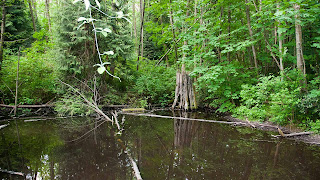 |
| https://www.pacificparklands.com/project/camosun-bog/ |
The famous Vancouver bog, called "Camosun bog", began developing as early as 5,000 years ago. It started out as a lake, then became into a swamp, and now became the famous bog, the Camosun bog. Back in the year 1929, the bog became very dry due to housing as it was intruding the bog area, but the city of Vancouver added drains to solve the problem. All kinds of plant species started growing in the area, even invasive bog species, such as the Hemlock. Hemlock trees started growing, but were taken down in 1991 as it was an invasive species to the bog. To improve the conditions of bog, the city of Vancouver then started growing sphagnum moss. Their plan was to initially restoring the bog, but as of now it is more of maintaining the bog to be healthy and prevent from drying. A group of volunteers from the communities, and as well as from schools gather every week and work on restoring the bog. In order to restore the bog to its previous glory, volunteers had to remove hemlock trees and other invasive plants, lower the ground, and also plant more sphagnum moss. Without the students and volunteers, the bog would not be what it is today, healthy and moist.
 |
| https://www.flickr.com/photos/aloalosabine/4279892371 |
The Camosun bog was and still is important to the Musqueam people. The Camosun bog is an essential part of the Musqueam history, to them, the bog told stories, memories, and the symbol for life itself. Destroying the bog would mean erasing all the traces of their history, since the bog has always been there even before urbanization and everything else. Reducing the bog size due to urbanization would be like calling the bog useless, and unusable to the Western people. Grant hopes one day that the bog will become bigger and use the bog as a learning tool for future generations and as to why it is important. To Musqueam people, the bog is essential to their stories and destroying something so beautiful and helpful would be calamitous to the.
 |
| https://www.ubyssey.ca/features/larry-grant-finds-a-voice/ |
Larry Grant is an individual of Chinese and Musqueam descent. He speaks the language of the Musqueam people, he can also speak and understand Cantonese since his father came from Guangdong in China. Grant's father immigrated to Canada in the 1920's, his father worked at a farm where he later met his wife, Grant's mother. Back then, the Indian Act was still in effect, it was an Act where non-Indigenous people were not allowed to interact with the Indigenous in the reserve. Although the Act was still in effect, Larry's parents got together and raised four children. Among the four children, Larry is the second son, as well as the second child, therefore he was often called "number two" by his family. In both of his parents' cultures, the first son inherits everything; this caused Grant to be more aware and be more educated about his two different cultures. Larry had many struggles with his identity when he was growing up, he was not able to attend Indigenous schools due to his Chinese background, but he did not feel as though he was part of the Chinese community. His grandfather was a well known wealthy logging contractor and helped clear Point Grey, but despite his wealth, he gave everything away and only kept the things he needed. Larry was confused as to why his grandfather did that and took him a while to understand why. Larry came to the conclusion that being wealthy does not necessarily make an individual posses a ton of money, but rather mean they have a lot to share.
 |
| https://students.ubc.ca/ubclife/discover-place-musqueam-post |
The totem pole is carved by a Musqueam artist, and the pole tells the story of how and where their name originated. The story with a double-headed serpent that resided in a small lake, which is now known as the Camosun bog, the elders spoke of the serpent to the youth, warning them to never be too close to the lake or they would meet their end. The serpent created a path that now became a river which passes through Musqueam, it created a plant called "
məθkʷəy̓". The Musqueam people were named after this plant, which symbolizes their rich history, culture, and connection to the Camosun bog.








Comments
Post a Comment